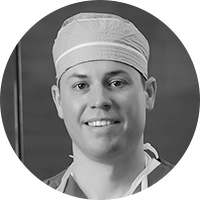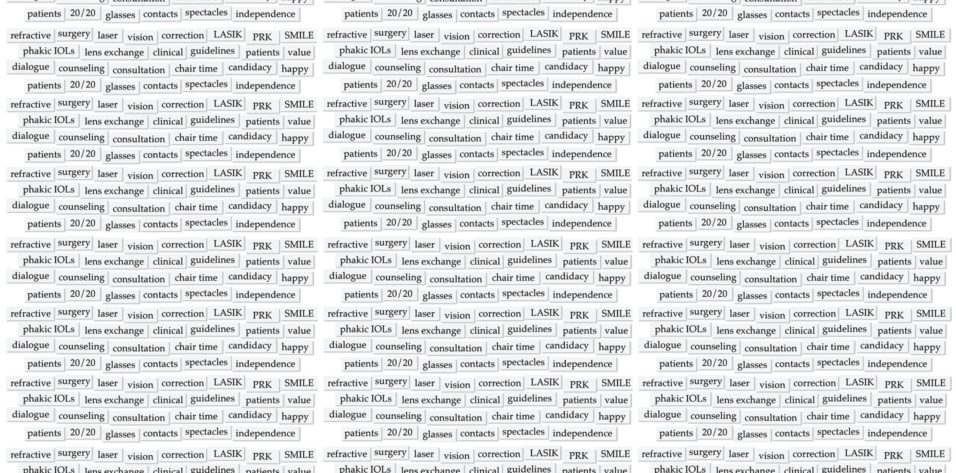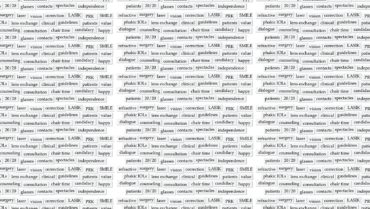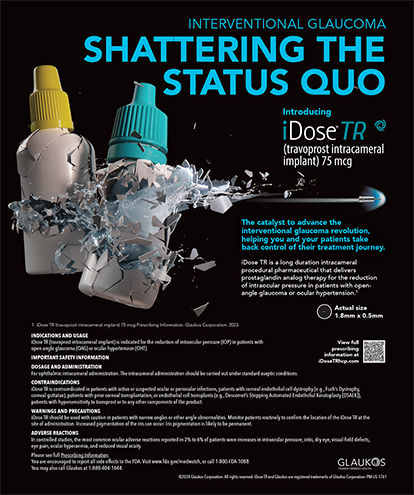

The COVID-19 pandemic has brought about a welcome (albeit somewhat unexpected) surge of patient interest in refractive surgery. Just a few months ago, it seemed impossible to conceive that a microscopic virus could force people to self-isolate and cease their normal lives virtually overnight. Necessary restrictions have disrupted daily routines, but they have also given hordes of people stuck at home the time to reprioritize and reevaluate what is most important to them. And, in some cases, to reallocate funds that were meant for childcare, vacations, and social life. The changes were not limited to stocking up on hand sanitizer and toilet paper; financial considerations extended to things people had always wanted to do but had been putting off.
For many people, reprioritization has turned into renewed interest in refractive surgery. During COVID-19 quarantines and self-isolation, people have had time to perform a cost-benefit analysis of refractive surgery versus the ongoing expense of monthly contacts. They have been frustrated with glasses that fog up during mask-wearing. They have endured changing work schedules and work venues, and they are attending more meetings via videoconference—adding to their dry eye issues due to the increase in screen time. And many now have more time to rest and recover after an elective surgical procedure, which they assumed might have kept them out of the office for several days in the pre-COVID world.
Our patients are not the only ones who have spent time reflecting on how to improve their lives; we have as well. Every business and medical practice has had to implement new procedures and safeguards. Proper sanitary protocols are not new to our profession, but we have enhanced our practices even further to ensure the safety and well-being of our patients and employees during a pandemic.
PREPARATIONS
Texas was not an early COVID hotspot in the United States, but our practice acted quickly to implement new policies and guidelines in anticipation of what was to come. In late March, a statewide shelter-in-place order mandated a ban on elective surgery, primarily to preserve personal protective equipment for hospital workers. Like most of the country, we continued seeing patients needing urgent and emergent care but did not perform any refractive surgery procedures for about 4 weeks.
When we reopened, we experienced not only pent-up demand from our rescheduled patients, but also a surge in new candidates eager to free themselves from the now memeworthy battle between eyewear and face masks (Figure). Our new patients’ demographics have ranged from students constantly on their computers to complete online coursework, to grandmothers tired of foggy readers, to those who now simply have the time to undergo and recover from procedures that previously felt impossible to fit into their schedules.

Figure. A member of Parkhurst NuVision’s staff recently underwent refractive surgery to avoid the frequent eye-touching associated with contact lens use.
SCREENING PROCEDURES
Every individual who enters our clinic—patient or staff member—is screened via a temperature check and symptom questionnaire. We exclude anyone from entering with even a hint of suspicious symptoms. Everyone must wear a face covering that properly covers both the nose and mouth.
We limit the number of people in our facility in three main ways:
- Some staff members work from home when feasible based on job duties;
- Only one guest is allowed per patient for evaluations and surgery; and
- We schedule a reduced number of in-person appointments.
We also use technology and efficiencies to accomplish good social distancing practices, such as having our front desk staff check in patients electronically through an online portal on their own device, immediately escorting patients to a disinfected exam lane, and eliminating wait time in the main lobby. When a technician approaches a patient for testing, that patient is first escorted to a handwashing station and educated on our new sanitary procedures. In the rooms where we perform our initial diagnostic tests, only two patients are permitted at a time, with at least 6 feet maintained between them. The surface of each instrument and the surrounding areas are thoroughly cleaned before and after use.
In addition to our clinic adaptations, we use telemedicine to connect to satellite communities surrounding San Antonio, allowing us to communicate with patients safely and efficiently. We can explore patients’ treatment options while they remain within the confines of their referring optometrist’s office after their optometrist has performed the initial evaluation. This process gives patients the convenience and safety of having to drive to our facility only on the day of their surgery.
The use of telemedicine eliminates at least three office visits and gives referring optometrists the ability to comanage their patients’ postoperative care. We have also replaced nearly all of our 1-week postoperative follow-ups with phone calls, further reducing patient visits as well as everyone’s risk of infection.
CHANGE IN PROCEDURE PROTOCOLS
One of the biggest surgical shifts we have made during this public health emergency has been further adoption of immediately sequential bilateral surgery. We have been performing same-day bilateral refractive lens exchange and phakic IOL implantation (Visian ICL, STAAR Surgical) for several years, so expanding our safety protocols to immediately sequential bilateral cataract surgery (ISBCS) was a seamless transition.
Performing ISBCS eliminates half of the required pre- and postoperative visits. It also allows us to reduce the number of patients passing through the surgery center every day by 50% while still treating the same number of eyes.
Just as we have made changes on the clinical side of our practice, safety measures and adaptive techniques have been put into place for surgery. Once patients enter our surgery center, they are screened with a standard temperature check and symptom questionnaire. Instead of waiting in our waiting area, they are brought directly to their preoperative surgical bay. Any guests who accompany patients to the appointment stay with them in the preoperative surgical bay. Each bay is surrounded by walls, limiting exposure to other patients.
Patients can now experience a smooth transition from their initial evaluation to the day of surgery and postoperative care with peace of mind due to the additional safety measures we have implemented.
Telemedicine and comanagement with referring optometrists have allowed us to reduce patient traffic. The use of masks with facial adhesive has been critical in keeping everything from phoropters to the femtosecond laser from fogging during exams and surgery.
CONCLUSION
Our patients have never been safer coming into our clinic, and we are confident in our ability to continue providing the utmost care. We have seen an increased demand from all ages and for all refractive procedures. Stress levels are high in every aspect of our lives right now, but, by constructing a logical and reasonable set of protocols, we can help create some sense of control and calmness to ease the uncertainty surrounding us.




